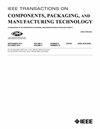Bonding Mechanism of Cold Gas-Sprayed Copper Particles Onto Aluminum Nitride Substrates for Power Electronics Packaging
IF 3
3区 工程技术
Q2 ENGINEERING, ELECTRICAL & ELECTRONIC
IEEE Transactions on Components, Packaging and Manufacturing Technology
Pub Date : 2025-04-25
DOI:10.1109/TCPMT.2025.3564520
引用次数: 0
Abstract
This study investigates the bonding mechanisms between cold gas-sprayed (CGS) copper (Cu) particles and aluminum nitride (AlN) substrates. A 300-电力电子封装用冷喷涂铜颗粒在氮化铝基板上的键合机理
本文研究了冷气喷涂(CGS)铜(Cu)颗粒与氮化铝(AlN)衬底的结合机理。成功地沉积了一层300- $\mu $ m厚的Cu涂层,并通过电子背散射衍射(EBSD)技术对其进行了表征,揭示了Cu涂层与Cu/AlN界面之间的微观结构演变差异。Cu/AlN界面表现出细小、均匀的晶粒和动态再结晶的迹象,而涂层的远端部分表现出较大的非均匀晶粒和较高的晶内应变。图像质量(IQ)图和晶粒取向扩展分析证实,Cu/AlN界面处的较低应变与较小的显微硬度读数相关,表明存在再结晶现象。颗粒冲击的有限元模拟显示了大的塑性变形、喷射和热响应,超过了铜的再结晶温度。这些发现表明,在Cu/AlN界面存在机械联锁和动态再结晶的键合机制。经过粗化处理的AlN衬底,平均表面粗糙度(Sa)为$0.5~\mu $ m,促进了机械联锁,从而增强了附着力。这项工作为优化陶瓷基板上金属涂层的CGS提供了见解,特别是在电子封装应用中,强金属-陶瓷附着力对于恶劣环境下的可靠运行至关重要。
本文章由计算机程序翻译,如有差异,请以英文原文为准。
求助全文
约1分钟内获得全文
求助全文
来源期刊

IEEE Transactions on Components, Packaging and Manufacturing Technology
ENGINEERING, MANUFACTURING-ENGINEERING, ELECTRICAL & ELECTRONIC
CiteScore
4.70
自引率
13.60%
发文量
203
审稿时长
3 months
期刊介绍:
IEEE Transactions on Components, Packaging, and Manufacturing Technology publishes research and application articles on modeling, design, building blocks, technical infrastructure, and analysis underpinning electronic, photonic and MEMS packaging, in addition to new developments in passive components, electrical contacts and connectors, thermal management, and device reliability; as well as the manufacture of electronics parts and assemblies, with broad coverage of design, factory modeling, assembly methods, quality, product robustness, and design-for-environment.
 求助内容:
求助内容: 应助结果提醒方式:
应助结果提醒方式:


